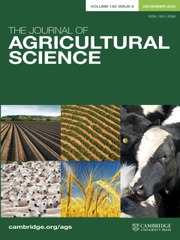No CrossRef data available.
Article contents
Tiller population dynamics and self-thinning law reveal stability mechanisms in mixed grass swards under variable grazing management
Published online by Cambridge University Press: 26 February 2025
Abstract
Grazing management is an important component affecting pasture stability, but the underlying demographic mechanisms remain poorly understood in mixed-species systems. This three-year study investigated how grazing height (15 and 20 cm pre-grazing) and strategic spring defoliation (7 cm) influence stability in mixed pastures composed of complementary C3/C4 grasses (Lolium arundinaceum and Cenchrus clandestinus). Utilising demographic and tiller size/density relationship theories, we examined population dynamics to better understand pasture stability. The results indicated that height management significantly affected the demographic traits, with shorter grazing (15 cm) increasing tiller emergence and population density while reducing individual tiller weight (TW). In addition, higher tiller population density (TPD) and lower TW were observed in the shorter treatments. Despite these contrasting responses, the mixed pasture maintained consistent stability across treatments through compensatory relationships between tiller traits. The stability index remained close to 1 (0.956 ± 0.02) regardless of management, demonstrating robust demographic equilibrium. Individual species showed distinct seasonal stability patterns – L. arundinaceum dominating in winter and C. clandestinus in spring and summer – yet their complementary growth maintained year-round system stability. The self-thinning law effectively revealed stable size-density compensation across treatments, suggesting its utility for assessing mixed sward persistence. These findings demonstrate that mixed pastures can maintain demographic stability under varying grazing regimes through species complementarity and population compensatory mechanisms.
- Type
- Crops and Soils Research Paper
- Information
- Copyright
- © The Author(s), 2025. Published by Cambridge University Press



